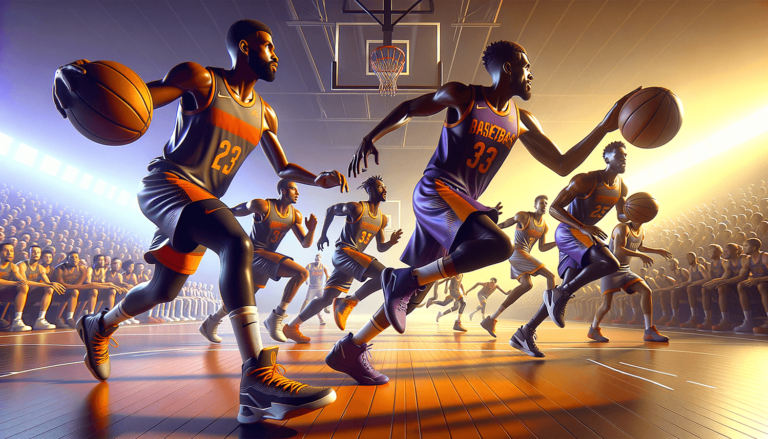
Rise of Positionless Basketball and Versatile Players
Written by: Basketball Universe
Last updated:

Welcome to the exciting world of positionless basketball, where traditional roles are redefined, and versatility reigns supreme! Gone are the days when players were pigeonholed into specific positions on the court – enter the era dominated by multi-dimensional athletes, capable of dominating in multiple aspects of the game. In today’s blog, we’ll dive deep into the rise of positionless basketball and explore the fascinating evolution of versatile players who have changed the landscape of the sport as we know it. So strap on your high-tops, and let’s embark on a thrilling journey through the hoops world of adaptability and boundless creativity!
Rise of Positionless Basketball and Versatile Players
The rise of positionless basketball and versatile players can be attributed to the increased emphasis on spacing, quick ball movement, and offensive efficiency in modern basketball strategies. Teams seek out players who can perform multiple roles, leading to the blurring of traditional positional boundaries. As a result, players have developed their skills in various aspects of the game, transitioning between roles while successfully adapting to the gameplay. This evolution has led to a more dynamic and unpredictable playing style, enhancing the spectator experience and further popularizing the sport.
The Genesis of Positionless Basketball
When we talk about basketball history, there is always an element of evolution in the narrative. To understand the rise of positionless basketball and versatile players, let’s first transport ourselves back to the traditional basketball structure decades ago. Players were confined to specific positions and roles: point guards managed the team’s tempo and executed plays, shooting guards specialized in outside shooting, small forwards balanced between defense and scoring from the perimeter, power forwards dominated the post, and centers acted as rim protectors and high-scoring forces down low.
Even notable Hall of Famers such as Magic Johnson and Larry Bird were disrupting the definitions of traditional positions back in the 80s. However, the real shift occurred in the early 2000s, when a new wave of players debuted, sparking conversations around the concept of positionless basketball. This shift coincided with the emergence of the ‘Seven Seconds or Less’ Phoenix Suns, who mastered a run-and-gun offense style focused on quick shot selection and the utilization of versatile players, setting the stage for the modern game.
Unearthing Gems: The Versatile Players
The Trailblazers
In order to appreciate the vanguard of versatile players who were instrumental in the rise of positionless basketball, it’s essential to acknowledge the trailblazing giants who paved the way. Spearheading the charge were standout players like Kevin Garnett and Tim Duncan, defying the expectations of traditional roles in their respective positions. Their unique stature, skillset, and athleticism enabled them to execute tasks reserved for point guards and perimeter players, serving as a harbinger of the game’s future trajectory.
The Game Changers
As the NBA continued to evolve, transcendent talents such as LeBron James, Kevin Durant, and Giannis Antetokounmpo elevated the concept of versatile players to new heights. LeBron James’ career has exemplified the blending of positions, as he showcased abilities rivaled only by some of the greatest point guards, despite matching up physically with power forwards. Similarly, Kevin Durant’s lethal scoring arsenal and Giannis Antetokounmpo’s unstoppable drive to the basket defied the expectations dictated by their physical stature, making them all-encompassing forces on the court.
The Modern Mavens
In recent years, we’ve seen growing numbers of big men emulating their predecessors and expanding their skillset to include three-point shooting and passing abilities. Players like Nikola Jokic, and Karl-Anthony Towns are prime examples of centers who break away from traditional big man roles, enhancing the offensive strategy execution through their refined skills.
Finding the Perfect Fit: Positionless Strategy
The Need for Multi-Role Players
Positionless basketball has garnered momentum as teams search for the perfect fit for their rosters. A successful positionless system demands players who not only possess refined skills in multiple areas but also seamlessly adapt to the flow of the game.
The beauty of positionless basketball lies in the adaptability it offers teams during tight matchups. Teams can now utilize versatile players to take advantage of opponents’ weaknesses, switch defensive assignments, and alter their offensive schemes according to real-time decisions. This strategic flexibility has revolutionized the way modern teams approach game planning and tactics.
Unlocking the Power of Positionless Basketball
Teams looking to master positionless basketball must have a solid understanding of the tenets that underlie this innovative paradigm. It’s crucial for coaches and players alike to personify these principles, which include:
- Embracing the potential of versatile skillsets
- Encouraging constant ball movement
- Creating mismatches that play to the strengths of their roster
- Prioritizing defensive schemes that utilize switching and communication
- Developing an unselfish mentality that values the contribution of all five players on the court
The Ripple Effect of Positionless Basketball
Impact on Player Development
The rise of positionless basketball has undisputed consequences, the most tangible of which is player development. Today, coaches, trainers, and players emphasize the nurturing of well-rounded athletes with skillsets that cater to multiple positions. These athletes must be effective on both ends of the court, which has resulted in more structured youth programs that promote versatility and development across all facets of the game.
A Change in Scouting Practices
The influence of positionless basketball has inevitably extended to the world of scouting. Talent evaluators and front offices now search for raw prospects that can fill multiple positions and boast various attributes essential to a versatile system. As a result, the criteria for a promising draft pick have expanded, culminating in increased diversity in terms of athleticism, skills, and basketball IQ.
Adapt or Perish: A Coaching Imperative
The coaching landscape has also shifted in response to the growing importance of positionless basketball. Coaches must now implement innovative systems that fully maximize the potential of their versatile players, often embracing a more fluid style of play while catering to players’ diverse abilities.
This coaching shift demands a delicate balance; coaches still need to prioritize fundamental aspects of the game, such as shot selection, defensive assignments, and rebounding. Ultimately, having players equipped with diverse skillsets makes it possible for coaches to innovate and establish a unique identity for their teams while creating favorable outcomes during game-time situations.
Will Positionless Basketball Dominate the Future?
The rise of positionless basketball has led to thrilling moments on the court and further enriched the sport of basketball. The blend of versatile players and fluid coaching schemes continues to create riveting storylines and dazzling spectacles. However, as with any evolutionary process, the future of positionless basketball remains uncertain. Will it continue to dominate conversations around the game, or will a new style of play emerge to take its place? Only time will tell, but one thing is for sure: the fans are in for a thrilling ride.
The Role of Analytics in Positionless Basketball
In recent years, advanced analytics have played a significant role in shaping the landscape of basketball. The reliance on analytics has helped in uncovering hidden talents and creating opportunities for versatile players. The emphasis on metrics such as Player Efficiency Rating (PER), True Shooting Percentage (TS%), and Value Over Replacement Player (VORP) has led to a deeper understanding of players’ value when they adopt multiple positions on the court. This data-driven approach allows coaches and general managers to tap into the potential of talented role players and deploy them in innovative ways.
Pushing Physical Limits: Training for Versatility
Positionless basketball has also dramatically impacted athletic training regimens. As players strive to be more versatile, conditioning, strength training, and skills development become increasingly important. Players aiming to excel in multiple positions must develop a variety of skills and maintain the physical attributes necessary for effective on-court performance. Consequently, training routines now cater to cultivating adaptability through activities such as yoga, resistance training, and exercise regimens tailored specifically to the needs of each player.
Role Models in the Positionless Paradigm
The rise of positionless basketball has blessed the game with exceptional talents that younger, aspiring players can idolize. This unique playing style has showcased the likes of Draymond Green, Klay Thompson, and Kawhi Leonard, who redefine defensive excellence and showcase extraordinary offensive versatility. Additionally, players such as Ben Simmons and Luka Doncic exemplify the marvel of multifaceted point forwards who seamlessly manage both guard and forward positions. With these role models taking center stage in the NBA, young players can now indulge in dreams of fully unlocking their potential, regardless of traditional position limitations.
Positionless Basketball in Amateur and Collegiate Levels
While the rise of positionless basketball has largely impacted professional teams, it’s important to note that the concept has trickled down to the amateur and collegiate levels as well. Coaches who have embraced the positionless mindset now focus on player development that nurtures versatile skillsets in their athletes. This ensures that young talents have a solid foundation in multiple aspects of the game, which prepares them for promising careers in the professional leagues.
In conclusion, the journey of positionless basketball and versatile players from a novel concept to the dominating paradigm in modern basketball showcases the excitement and innovation in the sport today. As coaches, players, and teams continue exploring the possibilities this shift presents, it’s certain that basketball will continue to thrive and entertain fans as an ever-evolving spectacle.
FAQ: Positionless Basketball and Versatile Players
Curious about positionless basketball and versatile players? Here’s a collection of frequently asked questions that can help you better understand the concept and the impact it has on the game. These questions delve deeper into specifics about this playing style and what makes it so transformative in the world of basketball.
1. Why has positionless basketball become more popular in recent years?
Positionless basketball has gained popularity due to its innovative approach to the game, which emphasizes offensive versatility and defensive flexibility. This style of play aims to exploit mismatches on the court, making it more difficult for opponents to strategize and defend. The rise of versatile players who excel in multiple positions has also played a significant role in the increasing popularity of positionless basketball.
2. Are there any drawbacks to positionless basketball?
While positionless basketball offers many strategic advantages, one potential drawback is the increased physical and skill-related demands on players. Versatile players must maintain a high level of fitness, conditioning, and expertise in different aspects of the game, which may result in fatigue and a higher risk of injury. However, modern training methods and sports science advancements help in mitigating these risks to some extent.
3. How has positionless basketball changed player development?
Positionless basketball has altered the way coaches and trainers approach player development. There’s now a greater emphasis on developing a well-rounded skillset, enhancing agility, and improving basketball IQ to ensure that players can perform multiple roles on the court effectively. This shift in focus has led to more versatile players, creating new possibilities for both individual athletic growth and team strategy.
4. How does positionless basketball affect team dynamics and player roles?
With positionless basketball, traditional player roles become more fluid, increasing the need for communication and collaboration among teammates. Players must learn to contribute effectively in multiple positions and adapt to varying situations in real-time, leading to a more cohesive and dynamic team identity.
5. Is positionless basketball the future of the sport?
While positionless basketball has undoubtedly made a significant impact on the game, it’s difficult to predict the trajectory of future basketball trends. As with any sport, basketball will continue to evolve as coaches and players experiment with new tactics and strategies. Positionless basketball could very well be a mainstay in the coming years, or new styles of play may emerge to take its place.
6. Can traditional role players still excel in positionless basketball?
Yes, traditional role players can still excel within the framework of positionless basketball. Coaches embracing this playing style often aim to utilize the strengths of their entire roster, which includes traditional role players. These players serve as valuable assets in specific situations, where their specialized skills can significantly contribute to the team’s success.
7. How do coaches implement positionless basketball systems?
Successful implementation of positionless basketball requires coaches to develop game plans that prioritize spacing, ball movement, and defensive switching. These systems need to be flexible and adaptive, allowing players to take advantage of their unique skillsets to create mismatches and exploit opportunities during gameplay.
8. Can positionless basketball be used in lower-level leagues like high school and college?
Yes, positionless basketball can be effectively used in lower-level leagues like high school and college. As a versatile approach to the game, it encourages coaches and players to focus on developing well-rounded skillsets and enhances adaptability. By adopting and promoting positionless basketball at an early stage, young players become better prepared to succeed in the professional ranks.
9. Which NBA teams are leading the way in positionless basketball?
Several NBA teams have embraced positionless basketball to great success, including the Golden State Warriors, Miami Heat, and Milwaukee Bucks. These teams often utilize versatile players with diverse skillsets, adopting fluid playing styles that disrupt traditional expectations and create exciting on-court spectacles.
10. How can aspiring basketball players develop the skillset needed for positionless basketball?
Aspiring basketball players can work on developing a versatile skillset by focusing on the fundamentals, honing their physical conditioning, and cultivating a deep understanding of the game. Participation in organized basketball activities, working with experienced coaches, and utilizing modern training methods can help young athletes build a comprehensive skillset needed for positionless basketball success.
Featured Posts
- No pillar pages found.




